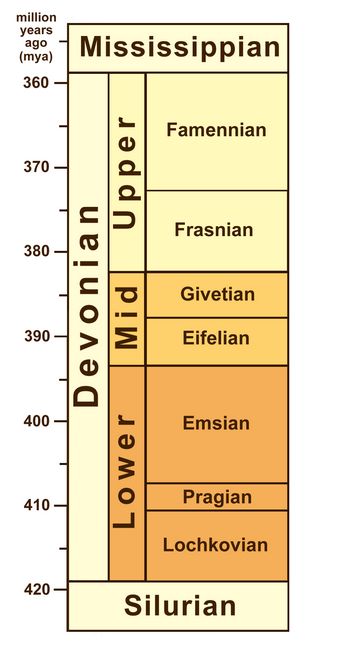Athena Review Image Archive ™
Devonian period stages

Stages in the Devonian period
The
Devonian period (419-359 mya), originally named for fossils and rock
formations found in Devonshire in southern England, was defined by
Roderick Murchison and Adam Sedwick between 1830-1840. They identified
the Devonian period with red and brown oxidized sedimentary deposits
known as the Old Red Sandstone.
The
Early Devonian period comprises the Lochkovian, Praghian and Emsian
stages (417-391 mya). The Middle Devonian period includes the Eifellian
and Givetian stages (391-370 mya), and the Late Devonian is
divided into the Frasnian and Famennian stages (370-354 mya).
The
Devonian period saw major shifting of continental plates related to
undersea tectonic and volcanic action. Convergence of the continents of
North American and Baltica in the Early Devonian created the continent
called Laurasia, which contained large zones of arid, near desert
conditions. This is the source of the Old Red Sandstone beds, which
contain hematite, typical of drought conditions. Collision of
continental plates also caused the Taconic and Caledonian orgenies,
resulting in the uplift of the northern Appalachian mountains of New
York state and Canada, and the Caledonian mountains in the British
Isles and Scandanavia. By the Permian period, Laurasia and Gondwana
would merge into the supercontinent Pangaea.
High
sea levels prevailed during the Devonian, often called the "Age of
Fishes." This was a time of major developments of aquatic groups, as
well as terrestial plants. Among vertebrates many branches of jawed
fish (gnathostomes) expanded. Armored fish called placoderms were
numerous during the lower stages of the Devonian period, but became
extinct in the Late Devonian.
The
first appearance of tetrapods occurred in the Late Devonian period,
when a group of early tetrapods derived from lobe-finned fish first
colonized the shorelines between 380 and 360 mya. This was preceded by
a branching of bony fishes (Ostyichthyes) into two main orders,
ray-finned fishes (actinopterygians) and lobe-finned fishes
(sarcopterygians). The pectoral fins of the latter were
modified into a pair of long, arthropod-like limbs which had elbow-like
joints, leading to evolution of fish-like tetrapods who were the direct
ancestors of amphibians.
References
Clack, Jennifer 2012. Gaining Ground
.Copyright © 1996-2020 Rust Family Foundation (All Rights Reserved).